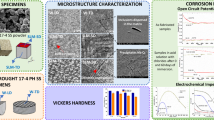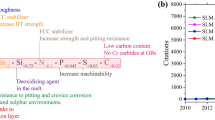Abstract
The intergranular corrosion (IGC) behavior of an extruded 6005A alloy profile with the coexisting of peripheral coarse grain (PCG) structure and partial recrystallized grain (PRG) structure was investigated by using an accelerated corrosion test, electrochemical impedance spectroscopy and a quasi in situ examination of IGC process. PCG structure was found to have a unique IGC behavior that pitting corrosion and subsequent IGC are less severe and will not be transformed into intragranular corrosion as they were found in PRG structure. Microstructure characterization reveals that the microstructural differences in grain boundary precipitates, primary α-AlFeMnSi intermetallic particles and grain characteristic between PCG structure and PRG structure are the reason for these phenomena. Further analysis indicates that the grain boundaries decorated with more AlFeMnSi particles and Q phase precipitates are more sensitive to corrosion, where Q phase precipitates are the primary cathodes and the most important factor affecting IGC; AlFeMnSi particles are supposed to initiate pitting corrosion since they are dissolved as anodes in the early stage of corrosion. With the development of corrosion, they are transformed into cathodes and become the bridges of IGC propagation by connecting the Q phase precipitates at grain boundary. In addition, grain characteristic was also found to have great effects on IGC. With the decrease in grain size and the increase in the frequency of high-angle grain boundaries and the dislocation density, corrosion becomes more severe and more likely to be transformed into intragranular corrosion.











Similar content being viewed by others
References
Zhang C, Wang C, Zhang Q, Zhao G, Chen L (2019) Influence of extrusion parameters on microstructure, texture, and second-phase particles in an Al–Mg–Si alloy. J Mater Process Technol 270:323–334
Svenningsen G, Larsen MH, Walmsley JC, Nordlien JH, Nisancioglu K (2006) Effect of artificial aging on intergranular corrosion of extruded AlMgSi alloy with small Cu content. Corros Sci 48:1528–1543
Svenningsen G, Lein JE, Bjorgum A, Nordlien JH, Yu YD, Nisancioglu K (2006) Effect of low copper content and heat treatment on intergranular corrosion of model AlMgSi alloys. Corros Sci 48:226–242
Larsen MH, Walmsley JC, Lunder O, Mathiesen RH, Nisancioglu K (2008) Intergranular corrosion of copper-containing AA6xxx AlMgSi aluminum alloys. J Electrochem Soc 155:C550–C556
Zou Y, Liu Q, Jia ZH, Xing Y, Ding LP, Wang XL (2017) The intergranular corrosion behavior of 6000-series alloys with different Mg/Si and Cu content. Appl Surf Sci 405:489–496
Liang WJ, Rometsch PA, Cao LF, Birbilis N (2013) General aspects related to the corrosion of 6xxx series aluminium alloys: exploring the influence of Mg/Si ratio and Cu. Corros Sci 76:119–128
El-Menshawy K, El-Sayed AWA, El-Bedawy ME, Ahmed HA, El-Raghy SM (2012) Effect of aging time at low aging temperatures on the corrosion of aluminium alloy 6061. Corros Sci 54:167–173
Larsen MH, Walmsley JC, Lunder O, Nisancioglu K (2010) Effect of excess silicon and small copper content on intergranular corrosion of 6000-series aluminium alloys. J Electrochem Soc 157:C61–C68
Kairy SK, Alam T, Rometsch PA, Davies CHJ, Banerjee R, Birbilis N (2016) Understanding the origins of intergranular corrosion in copper-containing Al–Mg–Si alloys. Metall Mater Trans A Phys Metall Mater Sci 47A:985–989
Guillaumin V, Mankowski G (2000) Localized corrosion of 6056 T6 aluminium alloy in chloride media. Corros Sci 42:105–125
Zhang WL, Frankel GS (2003) Transitions between pitting and intergranular corrosion in AA2024. Electrochim Acta 48:1193–1210
Chen MY, Deng YL, Tang JG, Fan ST, Zhang XM (2019) A study of the crystallographic pitting behavior of Al-0.54 Mg-0.66 Si aluminum alloy in acidic chloride solutions. Mater Charact 148:259–265
Zhang XX, Zhou XR, Hashimoto T et al (2017) The influence of grain structure on the corrosion behaviour of 2A97-T3 Al–Cu–Li alloy. Corros Sci 116:14–21
Zhang XX, Zhou XR, Hashimoto T et al (2018) Corrosion behaviour of 2A97-T6 Al–Cu–Li alloy: the influence of non-uniform precipitation. Corros Sci 132:1–8
Luo C, Zhou X, Thompson GE, Hughes AE (2012) Observations of intergranular corrosion in AA2024-T351: the influence of grain stored energy. Corros Sci 61:35–44
Ly R, Hartwig KT, Castaneda H (2018) Effects of strain localization on the corrosion behavior of ultra-fine grained aluminum alloy AA6061. Corros Sci 139:47–57
Guerin M, Alexis J, Andrieu E, Laffont L, Lefebvre W, Odemer G, Blanc C (2016) Identification of the metallurgical parameters explaining the corrosion susceptibility in a 2050 aluminium alloy. Corros Sci 102:291–300
Zhang XX, Jiao YB, Yu Y, Liu B, Hashimoto T, Liu HF, Dong ZH (2019) Intergranular corrosion in AA2024-T3 aluminium alloy: the influence of stored energy and prediction. Corros Sci 155:1–12
Chakrabarti DJ, Laughlin DE (2004) Phase relations and precipitation in Al–Mg–Si alloys with Cu additions. Prog Mater Sci 49:389–410
Kairy SK, Rometsch PA, Diao K, Nie JF, Davies CHJ, Birbilis N (2016) Exploring the electrochemistry of 6xxx series aluminium alloys as a function of Si to Mg ratio, Cu content, ageing conditions and microstructure. Electrochim Acta 190:92–103
Kairy SK, Birbilis N, Rometsch PA, Davies CHJ (2015) The influence of copper additions and aging on the microstructure and metastable pitting of Al–Mg–Si alloys. Corrosion 71:1304–1307
Kairy SK, Rometsch PA, Davies C, Birbilis N (2017) On the intergranular corrosion and hardness evolution of 6xxx series Al-alloys as a function of Si: Mg ratio, Cu content and ageing condition. Corrosion 73:1280–1295
Kairy SK, Rometsch P, Davies C, Birbilis N (2017) On the electrochemical and quasi in situ corrosion response of the Q-phase (AlxCuyMgzSiw) intermetallic particle in 6xxx series Al-alloys. Corrosion 73:87–99
Svenningsen G, Larsen MH, Nordlien JH, Nisancioglu K (2006) Effect of high temperature heat treatment on intergranular corrosion of AlMgSi(Cu) model alloy. Corros Sci 48:258–272
Svenningsen G, Larsen MH, Nordlien JH, Nisancioglu K (2006) Effect of thermomechanical history on intergranular corrosion of extruded AlMgSi(Cu) model alloy. Corros Sci 48:3969–3987
Remoe MS, Marthinsen K, Westermann I, Pedersen KT, Royset J, Marioara C (2017) The effect of alloying elements on the ductility of Al–Mg–Si alloys. Mater Sci Eng A Struct Mater Prop Microstruct Process 693:60–72
Yasakau KA, Zheludkevich ML, Lamaka SV, Ferreira MGS (2007) Role of intermetallic phases in localized corrosion of AA5083. Electrochim Acta 52:7651–7659
Birbilis N, Buchheit RG (2005) Electrochemical characteristics of intermetallic phases in aluminum alloys—an experimental survey and discussion. J Electrochem Soc 152:B140–B151
Zander D, Schnatterer C, Altenbach C, Chaineux V (2015) Microstructural impact on intergranular corrosion and the mechanical properties of industrial drawn 6056 aluminum wires. Mater Des 83:49–59
Kumari S, Wenner S, Walmsley JC, Lunder O, Nisancioglu K (2019) Progress in understanding initiation of intergranular corrosion on AA6005 aluminum alloy with low copper content. J Electrochem Soc 166:C3114–C3123
Li H, Zhao PP, Wang ZX, Mao QZ, Fang BJ, Song RG, Zheng ZG (2016) The intergranular corrosion susceptibility of a heavily overaged Al–Mg–Si–Cu alloy. Corros Sci 107:113–122
De Pari L, Misiolek WZ (2008) Theoretical predictions and experimental verification of surface grain structure evolution for AA6061 during hot rolling. Acta Mater 56:6174–6185
Minoda T, Yoshida H (2002) Effect of grain boundary characteristics on intergranular corrosion resistance of 6061 aluminum alloy extrusion. Metall Mater Trans A Phys Metall Mater Sci 33:2891–2898
Wloka J, Hack T, Virtanen S (2007) Influence of temper and surface condition on the exfoliation behaviour of high strength Al–Zn–Mg–Cu alloys. Corros Sci 49:1437–1449
Ralston KD, Birbilis N, Davies CHJ (2010) Revealing the relationship between grain size and corrosion rate of metals. Scr Mater 63:1201–1204
Zhang XX, Zhou XR, Nilsson JO, Dong ZH, Cai CR (2018) Corrosion behaviour of AA6082 Al–Mg–Si alloy extrusion: recrystallized and non-recrystallized structures. Corros Sci 144:163–171
Khireche S, Boughrara D, Kadri A, Hamadou L, Benbrahim N (2014) Corrosion mechanism of Al, Al–Zn and Al–Zn–Sn alloys in 3 wt.% NaCl solution. Corros Sci 87:504–516
Cabot PL, Garrido JA, Perez E, Moreira AH, Sumodjo PTA, Proud W (1995) Eis study of heat-treated Al–Zn–Mg alloys in the passive and transpassive potential regions. Electrochim Acta 40:447–454
Chen WC, Wen TC, Gopalan A (2002) Negative capacitance for polyaniline: an analysis via electrochemical impedance spectroscopy. Synth Met 128:179–189
Suter T, Alkire RC (2001) Microelectrochemical studies of pit initiation at single inclusions in Al 2024-T3. J Electrochem Soc 148:B36–B42
Tan L, Allen TR (2010) Effect of thermomechanical treatment on the corrosion of AA5083. Corros Sci 52:548–554
Yang WC, Ji SX, Li Z, Wang MP (2015) Grain boundary precipitation induced by grain crystallographic misorientations in an extruded Al–Mg–Si–Cu alloy. J Alloy Compd 624:27–30
Liu Y, Zhou X, Thompson GE, Hashimoto T, Scamans GM, Afseth A (2007) Precipitation in an AA6111 aluminium alloy and cosmetic corrosion. Acta Mater 55:353–360
Zhang RF, Qiu Y, Qi YS, Birbilis N (2018) A closer inspection of a grain boundary immune to intergranular corrosion in a sensitised Al–Mg alloy. Corros Sci 133:1–5
Wang ZX, Zhu F, Zheng K et al (2018) Effect of the thickness reduction on intergranular corrosion in an under-aged Al–Mg–Si–Cu alloy during cold-rolling. Corros Sci 142:201–212
Pantleon W (2008) Resolving the geometrically necessary dislocation content by conventional electron backscattering diffraction. Scr Mater 58:994–997
Soltis J (2015) Passivity breakdown, pit initiation and propagation of pits in metallic materials—review. Corros Sci 90:5–22
Eckermann F, Suter T, Uggowitzer P, Afseth A, Schmutz P (2008) The influence of MgSi particle reactivity and dissolution processes on corrosion in Al–Mg–Si alloys. Electrochim Acta 54:844–855
Shen PY, Tang JG, Ye LY, Duan CX, Den YL (6005A) Effect of microstructure heterogeneity on intergranular corrosion susceptibility of Al-alloy 6005A. Chin J Mater Res 32:751–758 (in Chinese)
Acknowledgements
The authors gratefully acknowledge the financial support of this work by National Natural Science Foundation (Project No. 51474240) and Provincial Science and Technology Major Project of Hunan province (Project No. 2016KG1004).
Author information
Authors and Affiliations
Corresponding author
Ethics declarations
Conflicts of interest
The authors declare that they have no conflict of interest to this work.
Additional information
Publisher's Note
Springer Nature remains neutral with regard to jurisdictional claims in published maps and institutional affiliations.
Rights and permissions
About this article
Cite this article
Duan, C., Tang, J., Ma, W. et al. Intergranular corrosion behavior of extruded 6005A alloy profile with different microstructures. J Mater Sci 55, 10833–10848 (2020). https://doi.org/10.1007/s10853-020-04692-6
Received:
Accepted:
Published:
Issue Date:
DOI: https://doi.org/10.1007/s10853-020-04692-6




